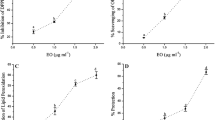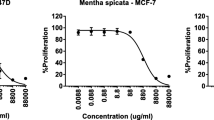Abstract
The aim of the work was to investigate antitumoral effect of essential oils on cancer cells and their possible protective (antioxidant) effects against hydrogen peroxide-induced cytotoxicity. Also, in vitro antioxidant properties of essential oils and aqueous extracts from wild form and cultivated form of Salvia pisidica were compared.
We found out that essential oils from wild form (IC50 128, and 85.17 μg /mL) and cultivated form (IC50 115.00 and 74.83 μg/mL) differed in their antitumoral effects on Hep G2 and H1299 cells respectively. As a very important we consider the finding that both essentials oils significantly reduced the cytotoxicity induced by the strong oxidant in cancer cells. We assume that protective effect of essential oils on cancer cells against H2O2 cytotoxicity can be accompanied by their antioxidant action.
Antioxidant properties of essential oils and aqueous extract from wild and cultivated S. pisidica were determined by different test systems. In DPPH assay, the weakest radical scavenging activity was exhibited by the aqueous extract from wild form (66.55 ± 1.15 μg/mL). Similarly inhibition of linoleic acid oxidation of aqueous extract from wild and cultivated form (50.93% and 59.66%) was lower than essential oils. In the case of reducing power assay and hydroxyl radical scavenging activity, a similar activity pattern was observed as given in the first two systems. Essential oils from wild and cultivated form had higher reducing power activity (EC50; 100.99 ± 3.0 and 96.87 ± 3.15 μg/mL) and hydroxyl radical scavenging activity (EC50; 15.99 ± 0.95 and 13.01 ± 1.35 μg/mL) than aqueous extracts.
Similar content being viewed by others
Abbreviations
- AqE:
-
aqueous extract
- CF:
-
cultivated form
- EsO:
-
essential oil
- EC50:
-
efficient concentration for 50% scavenging of radicals or reducing activity
- Hep G2:
-
hepatoma G2
- IC50:
-
concentration which inhibits 50% cell growth
- TPC:
-
total phenolics content
- WF:
-
wild form.
References
Areias F., Valentao P., Andrade P.B., Ferrere F., Seabra R.M., Dapkevicius A., Venskutonis R., van Beek T.A. & Linsson J.P.H. 2000. Flavonoids and phenolic acids of sage: Influence of some agricultural factors. J. Agric. Food. Chem. 48: 6081–6084.
Atoui A.K., Mansouri A., Boskou G. & Kefalas P. 2005. Tea and herbal infusions: Their antioxidant activity and phenolic profile. Food. Chem. 89: 27–36.
Balaban R.S., Nemoto S. & Finkel T. 2005. Mitochondria, oxidants and aging. Cell 120: 483–495.
Baser K.H.C., Kurkcuoglu M. & Aytac Z. 1998. Composition of the essential oil of Salvia euphratica Montbret et Aucher ex Bentham var. euphratica from Turkey. Flavour. Fragr. J. 13: 63–64.
Baser K.H.C., Ozek T., Kirimer N. & Tumen G. 1993. The essential oil of Salvia pomifera L. JEOR 5: 347–348.
Baser K.H.C., Beis S.H. & Ozek T. 1995. Composition of the essential oil of Salvia cryptantha Montbret et Aucher ex Benth. from Turkey. JEOR 7: 113–114.
Baser K.H.C., Demircakmak B. & Ermin N. 1996. Essential oil of Salvia syriaca L. JEOR 8: 105–106.
Baser K.H.C., Duman H., Vural M., Adiguzel N. & Aytac Z. 1997. Essential oil of Salvia aytachii. JEOR 9: 489–490.
Bozin B., Mlmica-Dukic N., Samojlik I. & Jovin E. 2007. Antimicrobial and antioxidant properties of rosemary and sage (Rosmarinus officinalis L. and Salvia officinalis L., Lamiaceae) essential oils. J. Agric. Food. Chem. 55: 7879–7885.
Dapkevicius A., Venskutonis R., van Beek T.A. & Linssen J.P.H. 1998. Antioxidant activity of extracts obtained by different isolation procedures from some aromatic herbs grown in Lithuania. J. Sci. Food. Agr. 77: 140–146.
Darmanin S. Wismayer P.S., Podesta M.T.C., Micallef M.J. & Buhagiar J.A. 2009. An extract from Ricinus communis L. leaves possesses cytotoxic properties and induces apoptosis in SK-MEL-28 human melanoma cells. Nat. Prod. J. 23: 561–571.
Demirci B., Demirci F., Donmez A., Franz G., Paper D. & Baser K.H.C. 2005. Effects of Salvia essential oils on the chorioallantoic membrane (CAM) assay. Pharmaceut. Biol. 43: 666–671.
Demirci B., Baser K.H.C. & Tumen G. 2002. Composition of the essential oil of Salvia aramiensis Rech. fil. Growing in Turkey. Flavour. Fragr. J. 17: 23–25.
Demirci B., Baser K.H.C., Yildiz B. & Bahcecioglu Z. 2003. Composition of the essential oils of six Salvia spp. from Turkey. Flavour. Fragr. J. 18: 116–121.
Fiskin K., Ozkan A. & Ayhan AG. 2006. Investigation of protective effects of selenium and vitamin e against DNA oxidation, membrane damage and alteration of COMT metabolism in smoke-exposed male mice (Mus musculus, Balb/c). Acta Biol. Hung. 57: 403–413.
Gloeckner H., Jonuleit T. & Lemke H.D. 2001. Monitoring of cell viability and cell growth in a hollow-fiber bioreactor by use of the dye Alamar Blue. J. Immunol. Meth. 252: 131–138.
Halliwell B. 1978. Superoxide-dependent formation of hydroxyl radicals in presence of iron chelates — is it a mechanism for hydroxyl radical production in biochemical systems. FEBS Lett. 92: 321–326.
Halliwell B., Gutteridge J.M.C. & Aruoma O. I. 1987. The deoxy ribose method: a simple test tube assay for determination of rate constants for reaction of hydroxyl radicals. Anal. Biochem. 165: 215–219.
Horvathova E., Turcaniova V. & Slamenova D. 2007. Comperative study of DNA-damaging and DNA-protective effects of selected components of essential plant oils in human leukemic cells K562. Neoplasma 54: 478–483.
Hatano T., Kagawa H., Yasuhara T. & Okuda T. 1988. Two new flavonoids and other constituents in licorice root their relative astringency and radical scavenging effects. Chem. Pharm. Bull. 36: 1090–2097.
Kahl R. & Kappus H. 1993. Toxicology of the synthetic antioxidants BHA and BHT in comparison with the natural antioxidant vitamin E. Zeitschrift fur Lebensmittel-Untersuchung und -Forschung. 196: 329–338.
Kalantzakis G. & Blekas G. 2006. Effect of Greek sage and summer savory extracts on vegetable oil thermal stability. Eur. J. Lipid. Sci. Technol. 108: 842–847.
Kelen M. & Tepe B. 2008. Chemical composition, antioxidant and antimicrobial properties of the essential oils of three Salvia species from Turkish flora. Bioresource Technol. 99: 4096–4104.
Kirkman T.W. 1996. Statistics to use [Online]. Available: http://www.physics.csbsju.edu/stats/1996 [17 August 2008].
Klaunig J.E. & Kamendulis L.M. 2004. The role of oxidative stress in carcinogenesis. Annu. Rev. Pharmacol. 44: 239–267.
Miliauskasa G., Venskutonisa P.R. & van Beekb T.A. 2004. Screening of radical scavenging activity of some medicinal and aromatic plant extracts. Food Chem. 85: 231–237.
Nakano K., Nakayachi T., Yasumoto E., Morshed S.R.M.D., Hashimoto K., Kikuchi H., Nishikawa H., Sugiyama K., Amano O., Kawase M., & Sakagami H. 2004. Induction of apoptosis by beta-diketones in human tumor cells. Anticancer Res. 24: 711–717.
Oyaizu M. 1986. Studies on product of browning reaction prepared from glucose amine. Jpn. J. Nutr. 44: 307–315.
Ozkan A. & Fiskin K. 2004. Free oxygen radicals, carcinogenesis and antioxidant enzymes. Turk. J. Hematol. Oncol. 14: 52–60.
Ozkan A., Fiskin K. & Ayhan A. 2007. Effect of vitamin E and selenium on antioxidant enzymes in brain kidney and liver of cigarette smoke exposed mice. Biologia 62: 360–364.
Peng C.C., Chen K.C., Peng R.Y., Chena K.C., Peng R.Y., Chyaud C.C., Su C.H. & Hsieh-Li H.M. 2007. Antrodia camphorata extract induces replicative senescence in superficial TCC, and inhibits the absolute migration capability in invasive bladder carcinoma cells. J. Ethnopharmacol. 109: 93–103.
Potterat O. 1997. Antioxidants and free radical scavengers of natural origin. Current Organic Chem. 1: 1415–1419.
Ruberto G. & Barata M.T. 2000. Antioxidant activity of selected essential oil components in two lipid model systems. Food Chem. 69: 167–174.
Sacchetti G., Maietti S., Muzzoli M., Scaglianti M., Manfredini S., Radice M. & Bruni R. 2005. Comparative evaluation of 11 essential oils of different origin as functional antioxidants, antiradicals and antimicrobials in foods. Food Chem. 91: 621–632.
Shahidi F. 2000. Antioxidants in food and food antioxidants. Nahrung 44: 158–163.
Tepe B., Donmez., Unlub M., Candanc F., Dafererad D., Vardar-Unlub I., Polissioud M. & Somken A. 2004. Antimicrobial and antioxidative activities of the essential oils and methanol extracts of Salvia cryptantha (Montbret et Aucher ex Benth.) and Salvia multicaulis (Vahl). Food Chem. 84: 519–525.
Thompson D. & Moldeus P. 1988. Cytotoxicity of butylated hydroxyanisole and butylated hydroxytoluene in isolated rat hepatocytes. Biochem. Pharmacol. 37: 2201–2207.
Urek R.O., Kayali H.A., Nakiboglu M. & Tarhan L. 2008. Comparison of antioxidant capacities of the leaves and flowers of Salvia fruticosa grown in turkey. Asian J. Chem. 20: 2091–2098.
[US FDA] U.S. 1997. Food and Drug Administration. Butylated hydroxytoluene. Use restrictions. Washington, D.C.: U.S. Government Printing Office, Federal Register. 42: 27603–27607.
Viuda-Martos M., Ruiz-Navajas Y., Fernandez-Lopez J. & Perez-Alvarez J.A. 2007. Chemical composition of the essential oils obtained from some spices widely used in Mediterranean region. Acta. Chim. Sloven. 54: 921–927.
Willcox J.K., Ash S.L. & Catignani G.L. 2004. Antioxidants and prevention of chronic disease. Crit. Rev. Food Sci. Nutr. 44: 275–295.
Zheng W. & Wang S.Y. 2001. Antioxidant activity and phenolic compounds in selected herbs. J. Agric. Food Chem. 49: 5165–5170.
Author information
Authors and Affiliations
Corresponding author
Rights and permissions
About this article
Cite this article
Ozkan, A., Erdogan, A., Sokmen, M. et al. Antitumoral and antioxidant effect of essential oils and in vitro antioxidant properties of essential oils and aqueous extracts from Salvia pisidica . Biologia 65, 990–996 (2010). https://doi.org/10.2478/s11756-010-0108-5
Received:
Accepted:
Published:
Issue Date:
DOI: https://doi.org/10.2478/s11756-010-0108-5




